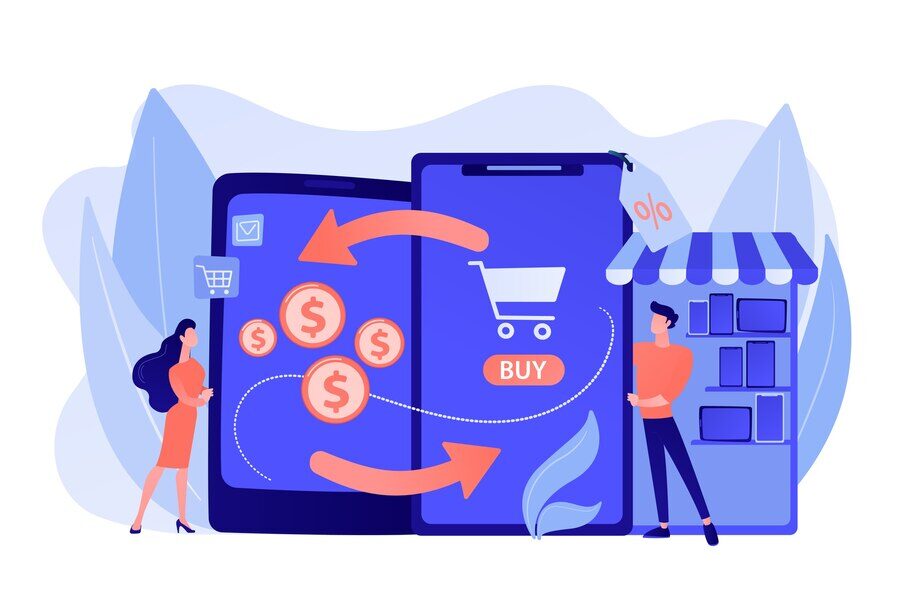Table of Contents
ToggleProjecting forward to 2027, forecasts indicate that eCommerce will soon account for nearly a quarter of global retail sales, building upon the impressive foundation laid in 2023 when online sales reached 19.5%. Given this remarkable trajectory, honing your e-commerce optimization skills becomes paramount to staying competitive and seizing opportunities presented by this booming sector.
This article explores five powerful strategies for optimizing eCommerce in the current era, designed particularly with the needs of contemporary entrepreneurs in mind. By building on proven industry standards, our 2024 ECommerce Optimization Guide equips you to enhance your brand’s online presence and achieve concrete results.
E-commerce Optimization Methods
Mobile Optimization

Image Source: Digital
The dominance of mobile commerce is absolute. Consumers research, browse, compare, and purchase seamlessly from their smartphones. Ignoring mobile optimization is commercial suicide.
Responsive & Adaptive Design: This is table stakes. Your website must fluidly adapt to any screen size and orientation. Beyond simple responsiveness, consider adaptive design elements that serve device-specific layouts for truly optimal experiences on smartphones, tablets, and desktops. Touch targets (buttons, links) need to be generously sized (minimum 48×48 pixels) and spaced to prevent frustrating mis-taps.
Thumb-Friendly Navigation: Design for one-handed use. Place primary navigation (menu, search, cart) within easy reach of the thumb – typically the bottom corners or a hamburger menu readily accessible from the lower half of the screen. Minimize the need for excessive scrolling or reaching across the screen.
Performance is Paramount:
Image Optimization: Compress images aggressively without sacrificing necessary quality. Use next-gen formats (WebP, AVIF) where supported. Implement lazy loading so images only load as they enter the viewport. Specify image dimensions to prevent layout shifts (CLS).
Code Minification & Compression: Minify HTML, CSS, and JavaScript files. Enable GZIP or Brotli compression on your server.
Reduce Redirects & Render-Blocking Resources: Each redirect adds latency. Eliminate unnecessary ones. Defer non-critical JavaScript and CSS to speed up initial page rendering. Leverage browser caching effectively.
Content Delivery Network (CDN): Distribute static assets (images, CSS, JS) across geographically dispersed servers to reduce load times globally.
Streamlined Checkout: This is where conversions are won or lost.
Guest Checkout: Always offer a frictionless guest checkout option. Forcing account creation is a major cart abandonment trigger.
Autofill & Digital Wallets: Integrate autofill capabilities and popular digital wallets (Apple Pay, Google Pay, PayPal) for one-tap purchasing. Reduce typing to an absolute minimum.
Progress Indicators: Clearly show users how many steps remain in the checkout process.
Simplified Forms: Request only essential information. Use clear labels, inline validation, and minimize fields.
Persistent Cart: Ensure the cart icon is always visible and accurately reflects contents.
Advanced Mobile Technologies:
Accelerated Mobile Pages (AMP): While its prominence has evolved, AMP remains valuable for content-heavy pages (blogs, news) where near-instantaneous loading is critical for engagement. It prioritizes speed by stripping down HTML and leveraging Google’s cache.
Progressive Web Apps (PWAs): These represent the cutting edge. PWAs combine the best of the web (discoverability, linkability) with native app-like experiences (offline functionality, push notifications, home screen installation, smooth animations). They load instantly, work reliably on any network, and provide an immersive, app-like interface, significantly boosting engagement and repeat visits.
Voice Search Optimization: As voice assistants proliferate, optimize product titles, descriptions, and content for natural language queries (“best running shoes for flat feet under $100”). Focus on long-tail keywords and question-based phrases.
Personalization for E-commerce Optimization

Image Source: Retail Rocket
Business leaders must harness the power of personalization, tailoring experiences to individual user preferences and behaviors for e-commerce optimization.
Implement these key tactics:
- Data Foundation: Effective personalization requires robust data collection and management (respecting privacy regulations like GDPR and CCPA). Key data points include:
- AI & Machine Learning: The Personalization Powerhouse: Algorithms analyze vast datasets in real-time to predict behavior and preferences.
- Real-Time Product Recommendations: Go beyond “Customers who bought this also bought…” Use sophisticated algorithms to power:
- “Recommended For You” on homepage/category pages.
- “Recently Viewed” reminders.
- “Complete the Look” or accessory suggestions on product pages.
- Personalized search results ranking.
- Dynamic upselling/cross-selling in cart and checkout.
- Dynamic Content: Tailor website content instantly:
- Personalized homepage banners featuring relevant categories or offers.
- Location-specific promotions or shipping messages.
- Displaying recently viewed items prominently.
- Showing content based on user stage (new visitor vs. loyal customer).
- Real-Time Product Recommendations: Go beyond “Customers who bought this also bought…” Use sophisticated algorithms to power:
- Personalized Email & Retargeting: Segmentation is key, but true personalization goes further:
- Triggered Emails: Abandoned cart reminders, browse abandonment nudges, back-in-stock alerts, post-purchase follow-ups (review requests, related product suggestions).
- Segmented Campaigns: Tailor newsletters and promotions based on purchase history, interests, engagement level, or demographics.
- Dynamic Email Content: Include personalized product recommendations, name, location-specific offers, or loyalty status within the email body.
- Personalized Retargeting Ads: Show ads featuring the exact products a user viewed or complementary items, across social media and display networks.
- Personalized On-Site Search & Navigation: Enhance the search bar with autocomplete suggestions based on popular searches and user history. Allow filtering based on personalized attributes (e.g., “My Usual Size”).
- User Profiles & Preferences: Empower customers to manage their preferences (communication frequency, product interests, size profiles). This explicit data significantly improves personalization accuracy.
- The impact is profound: Personalized experiences dramatically increase conversion rates, average order value (AOV), customer lifetime value (CLTV), and loyalty, while reducing acquisition costs and churn. Amazon’s relentless focus on personalization, analyzing wishlists, purchases, browsing, and cart behavior to serve hyper-relevant recommendations, is a masterclass in driving sales through relevance. Businesses that fail to personalize effectively will struggle to compete.
Leveraging AI and Machine Learning
The integration of AI and ML algorithms in e-commerce transforms how companies propose products to shoppers.
A prime example is Amazon utilizing ML algorithms for monitoring customer behavior within their platform, examining various aspects including users’ wishlists, previous acquisitions, regularly browsed sections, and discarded cart contents.
Based on this comprehensive dataset, Amazon recommends curated products that cater specifically to users’ needs and desires, often leading to increased sales.
By tapping into vast reserves of customer data – ranging from browsing histories to social media interactions – these advanced algorithms identify e-commerce trends, assess affinities, and predict future actions.
They then apply these insights to present relevant, timely, and appealing product selections, fostering greater customer satisfaction and brand loyalty.
Moreover, integrating AI-powered recommendations into your e-commerce optimization strategy offers significant advantages over traditional methods.
Implementing personalized experiences during e-commerce optimization for online shopping enhances customer satisfaction and raises the likelihood of larger orders, repeated purchases, and diminished marketing expenses owing to decreased client turnover.
- Chatbots & Virtual Assistants: Provide 24/7 customer support, answer FAQs, guide users through product selection, and resolve simple issues, freeing human agents for complex queries. Advanced AI chatbots learn from interactions to improve continuously.
- Visual Search: Allow users to search using images instead of text (e.g., take a photo of a dress and find similar items). Requires sophisticated image recognition AI.
- Predictive Analytics for Inventory & Demand Forecasting: Analyze historical sales data, seasonality, trends, and external factors (like weather or social media buzz) to predict future demand with high accuracy. This optimizes inventory levels, reduces stockouts and overstocking, and improves supply chain efficiency.
- Dynamic Pricing: AI algorithms can analyze competitor pricing, demand elasticity, inventory levels, time of day, and user behavior to adjust prices in real-time for maximum profitability and competitiveness (e.g., airline tickets, ride-sharing).
- Fraud Detection & Prevention: ML models analyze transaction patterns, user behavior, and device data to identify fraudulent activity with high precision, significantly reducing chargebacks and losses while minimizing false positives that block legitimate customers.
- Customer Service Optimization: AI can analyze support tickets and call center transcripts to identify common issues, agent performance, and customer sentiment, enabling process improvements and targeted training.
- Content Generation & Optimization: AI tools assist in generating product descriptions, meta tags, blog post ideas, and even ad copy, often optimized for SEO. They can also analyze content performance.
Using Data to Drive Sales and Marketing | ECommerce Optimization
In 2024, e-commerce success hinges on leveraging advanced analytics. Businesses unlock growth by:

- Advanced Customer Segmentation: Move beyond basic demographics. Use behavioral data, purchase history, CLTV, and engagement levels to create highly granular segments (e.g., “High-value customers who haven’t purchased in 60 days,” “Frequent browsers of category X but low converters”). Tailor messaging, offers, and experiences precisely to each segment’s motivations and needs.
- Predictive Analytics: Utilize AI-driven models to:
- Predict customer churn risk and proactively intervene with retention offers.
- Forecast lifetime value (LTV) to prioritize acquisition spending.
- Anticipate individual customer needs and next best actions (e.g., what product they might need next).
- Optimize marketing spend allocation across channels.
- Comprehensive Customer Journey Mapping: Track and visualize every single touchpoint a customer has with your brand – from first ad impression to post-purchase support. Use analytics tools to identify:
- Drop-off Points: Where are potential customers abandoning the journey? (e.g., specific page, checkout step).
- Friction Points: What causes frustration or confusion? (e.g., complex navigation, unclear shipping costs).
- High-Engagement Points: What content or features resonate most? Use these insights to systematically remove friction, enhance positive experiences, and streamline the path to purchase.
- Pricing Optimization: Leverage data for strategic pricing:
- Competitive Benchmarking: Monitor competitor prices dynamically.
- Price Elasticity Testing: Understand how sensitive demand is to price changes for different products/categories.
- Promotional Effectiveness: Measure the true impact of discounts and sales on revenue and profit, not just volume. Avoid constant discounting that erodes brand value.
- Dynamic Pricing: As mentioned under AI, use data-driven rules for real-time adjustments (where appropriate for the product type).
- Rigorous A/B & Multivariate Testing: Never assume. Test everything:
- Website Elements: Headlines, CTAs, button colors, layouts, images, product page copy.
- Marketing Campaigns: Email subject lines, ad creatives, landing page designs, offer structures.
- Checkout Flow: Number of steps, form fields, payment options displayed. Use statistical significance to ensure results are reliable. Data from tests provides incontrovertible evidence for optimization decisions.
- Attribution Modeling: Understand which marketing channels and touchpoints truly contribute to conversions in a complex, multi-channel journey. Move beyond simplistic “last-click” models to data-driven attribution (e.g., data-driven, position-based, time-decay) to allocate budget effectively.
Social proof and User-Generated Content
The impact of social proof on consumers’ decision-making when shopping online means that it is a crucial component of any effective e-commerce optimization approach.
It’s essential to motivate happy customers to write product reviews or give ratings on your website and showcase their feedback conspicuously across the site.
Moreover, integrating user-created content like images or videos demonstrating your products can enhance reliability and confidence.
An alternative method to harness social proof is by forming alliances with influencers whose principles match those of your brand and cater to your intended market.
This not only broadens your outreach but also includes a form of endorsement from a neutral party, which may assist in persuading uncertain clients.
Conclusion on E-commerce Optimization
E-commerce businesses must stay ahead by continually adapting to emerging trends and refining their online presence. By implementing essential eCommerce optimization techniques—from mobile optimization to AI-driven personalization—these businesses can enhance user experience, increase conversion rates, and ensure customer satisfaction.
The strategic employment of analytics, responsive design, and innovative technologies is key. Such forward-thinking practices not only drive immediate sales but also foster lasting customer loyalty, underpinning sustainable growth in the volatile online marketplace.
Frequently Asked Questions
What is e-commerce optimization?
E-commerce optimization entails fine-tuning diverse components of an internet storefront to elevate visibility, generate web traffic, amplify conversion rates, and boost overall efficiency. Such enhancements might encompass revamping the website’s appearance and ease of use, expediting checkout and transaction procedures, supplying tailored suggestions, and employing analytical software to fathom buyer habits and predilections.
Persistent experimentation, scrutiny, and modification of assorted facets yield a smooth and captivating purchase pathway, bolstering revenue and fostering enduring connections with patrons.
How do I optimize my online store?
To maximize your online store’s efficacy, follow critical stages. Initiate by crafting a tidy, instinctual format, facilitating visitors’ navigation. Feature top-notch imagery and particulars concerning merchandise; transparently present pricing and delivery details. Accelerate the verification procedure via versatile payments and condensed forms.
Apply SEO tactics to advance rankings in search outcomes and draw organically sourced guests. Introduce chatbots or automatic aids to tackle prevalent queries and apprehensions promptly. Ultimately, apply A/B tests and metrics instruments to monitor patron involvement and recognize segments needing improvement.
How do I optimize my e-commerce website for conversions?
Employ social evidence, including evaluations and endorsements, plus cooperative ventures alongside influencers. Generate distinct landings covering singular initiatives and offers, capitalizing on electronic correspondence to cultivate leads and sustain recurring transactions. Examine disparities among headers, callouts, and multimedia features, pinpointing winning blends appealing to your demographic base.
How can I improve my ecommerce system?
Merge ML algorithms governing suggestion machines and categorization schemes, delivering customized journeys. Continually seek input from both buyers and staff members, guiding forthcoming tweaks and renovations. Lastly, remain current regarding trade news and shifts, maintaining an edge against emerging rivals and adapting proactively toward shifting demand patterns.







